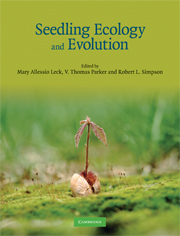Book contents
- Frontmatter
- Contents
- Contributors
- Foreword by Peter J. Grubb
- Preface
- Acknowledgments
- Part I Introduction
- Part II Seedling diversity
- Part III Seedling morphology, evolution, and physiology
- Part IV Life history implications
- Chapter 10 The seedling as part of a plant's life history strategy
- Chapter 11 Seedling recruitment and population ecology
- Chapter 12 Seedling communities
- Chapter 13 Spatial variation in seedling emergence and establishment – functional groups among and within habitats?
- Part V Applications
- Part VI Synthesis
- References
- Index
Chapter 12 - Seedling communities
Published online by Cambridge University Press: 05 June 2012
- Frontmatter
- Contents
- Contributors
- Foreword by Peter J. Grubb
- Preface
- Acknowledgments
- Part I Introduction
- Part II Seedling diversity
- Part III Seedling morphology, evolution, and physiology
- Part IV Life history implications
- Chapter 10 The seedling as part of a plant's life history strategy
- Chapter 11 Seedling recruitment and population ecology
- Chapter 12 Seedling communities
- Chapter 13 Spatial variation in seedling emergence and establishment – functional groups among and within habitats?
- Part V Applications
- Part VI Synthesis
- References
- Index
Summary
Introduction
This chapter considers the internal and external processes that affect seedling communities. Internal or endogenous drivers include the density dependence of seedling populations, as well as the relationship of parent to offspring and the competitive relationships affecting seedling populations. There are many external or exogenous drivers, but we will focus on climate, predation, and fire. We will integrate these internal and external drivers of community composition to address the questions: To what extent do seedling recruitment strategies relate to community assembly rules and do these rules dictate the potential combinations of regeneration niches to be found in any given community? This chapter will focus on long-lived woody species because the differences in life history stages and factors affecting them appear much more prominent than in some other growth forms.
Internal drivers
Communities of regeneration niches
Plant recruitment strategies have received a great deal of attention generally to determine the environmental conditions that favor one strategy over another (Chapter 11). Although communities comprise an assemblage of different seedling strategies, relatively little attention has been paid to the community combinations or rules that limit possible combinations. A useful concept for understanding seedling communities is that of safe sites (Harper, 1977), which is a species-specific phenomenon driven by unique aspects of ecology and phylogeny. It is important to recognize the diversity of potential safe sites and how they are distributed in space and time. Also of importance is how species reach safe sites and the role of metapopulations.
- Type
- Chapter
- Information
- Seedling Ecology and Evolution , pp. 255 - 273Publisher: Cambridge University PressPrint publication year: 2008
- 6
- Cited by



